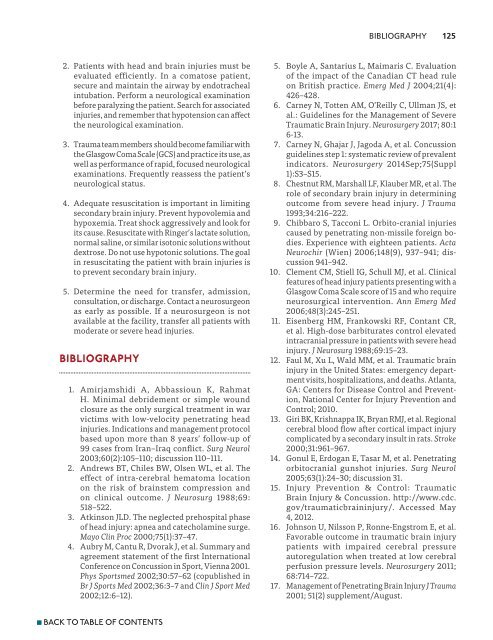Advanced Trauma Life Support ATLS Student Course Manual 2018
Create successful ePaper yourself
Turn your PDF publications into a flip-book with our unique Google optimized e-Paper software.
BIBLIOGRAPHY 125<br />
2. Patients with head and brain injuries must be<br />
evaluated efficiently. In a comatose patient,<br />
secure and maintain the airway by endotracheal<br />
intubation. Perform a neurological examination<br />
before paralyzing the patient. Search for associated<br />
injuries, and remember that hypotension can affect<br />
the neurological examination.<br />
3. <strong>Trauma</strong> team members should become familiar with<br />
the Glasgow Coma Scale (GCS) and practice its use, as<br />
well as performance of rapid, focused neurological<br />
examinations. Frequently reassess the patient’s<br />
neurological status.<br />
4. Adequate resuscitation is important in limiting<br />
secondary brain injury. Prevent hypovolemia and<br />
hypoxemia. Treat shock aggressively and look for<br />
its cause. Resuscitate with Ringer’s lactate solution,<br />
normal saline, or similar isotonic solutions without<br />
dextrose. Do not use hypotonic solutions. The goal<br />
in resuscitating the patient with brain injuries is<br />
to prevent secondary brain injury.<br />
5. Determine the need for transfer, admission,<br />
consultation, or discharge. Contact a neurosurgeon<br />
as early as possible. If a neurosurgeon is not<br />
available at the facility, transfer all patients with<br />
moderate or severe head injuries.<br />
Bibliography<br />
1. Amirjamshidi A, Abbassioun K, Rahmat<br />
H. Minimal debridement or simple wound<br />
closure as the only surgical treatment in war<br />
victims with low-velocity penetrating head<br />
injuries. Indications and management protocol<br />
based upon more than 8 years’ follow-up of<br />
99 cases from Iran–Iraq conflict. Surg Neurol<br />
2003;60(2):105–110; discussion 110–111.<br />
2. Andrews BT, Chiles BW, Olsen WL, et al. The<br />
effect of intra-cerebral hematoma location<br />
on the risk of brainstem compression and<br />
on clinical outcome. J Neurosurg 1988;69:<br />
518–522.<br />
3. Atkinson JLD. The neglected prehospital phase<br />
of head injury: apnea and catecholamine surge.<br />
Mayo Clin Proc 2000;75(1):37–47.<br />
4. Aubry M, Cantu R, Dvorak J, et al. Summary and<br />
agreement statement of the first International<br />
Conference on Concussion in Sport, Vienna 2001.<br />
Phys Sportsmed 2002;30:57–62 (copublished in<br />
Br J Sports Med 2002;36:3–7 and Clin J Sport Med<br />
2002;12:6–12).<br />
5. Boyle A, Santarius L, Maimaris C. Evaluation<br />
of the impact of the Canadian CT head rule<br />
on British practice. Emerg Med J 2004;21(4):<br />
426–428.<br />
6. Carney N, Totten AM, O’Reilly C, Ullman JS, et<br />
al.: Guidelines for the Management of Severe<br />
<strong>Trauma</strong>tic Brain Injury. Neurosurgery 2017; 80:1<br />
6-13.<br />
7. Carney N, Ghajar J, Jagoda A, et al. Concussion<br />
guidelines step 1: systematic review of prevalent<br />
indicators. Neurosurgery 2014Sep;75(Suppl<br />
1):S3–S15.<br />
8. Chestnut RM, Marshall LF, Klauber MR, et al. The<br />
role of secondary brain injury in determining<br />
outcome from severe head injury. J <strong>Trauma</strong><br />
1993;34:216–222.<br />
9. Chibbaro S, Tacconi L. Orbito-cranial injuries<br />
caused by penetrating non-missile foreign bodies.<br />
Experience with eighteen patients. Acta<br />
Neurochir (Wien) 2006;148(9), 937–941; discussion<br />
941–942.<br />
10. Clement CM, Stiell IG, Schull MJ, et al. Clinical<br />
features of head injury patients presenting with a<br />
Glasgow Coma Scale score of 15 and who require<br />
neurosurgical intervention. Ann Emerg Med<br />
2006;48(3):245–251.<br />
11. Eisenberg HM, Frankowski RF, Contant CR,<br />
et al. High-dose barbiturates control elevated<br />
intracranial pressure in patients with severe head<br />
injury. J Neurosurg 1988;69:15–23.<br />
12. Faul M, Xu L, Wald MM, et al. <strong>Trauma</strong>tic brain<br />
injury in the United States: emergency department<br />
visits, hospitalizations, and deaths. Atlanta,<br />
GA: Centers for Disease Control and Prevention,<br />
National Center for Injury Prevention and<br />
Control; 2010.<br />
13. Giri BK, Krishnappa IK, Bryan RMJ, et al. Regional<br />
cerebral blood flow after cortical impact injury<br />
complicated by a secondary insult in rats. Stroke<br />
2000;31:961–967.<br />
14. Gonul E, Erdogan E, Tasar M, et al. Penetrating<br />
orbitocranial gunshot injuries. Surg Neurol<br />
2005;63(1):24–30; discussion 31.<br />
15. Injury Prevention & Control: <strong>Trauma</strong>tic<br />
Brain Injury & Concussion. http://www.cdc.<br />
gov/traumaticbraininjury/. Accessed May<br />
4, 2012.<br />
16. Johnson U, Nilsson P, Ronne-Engstrom E, et al.<br />
Favorable outcome in traumatic brain injury<br />
patients with impaired cerebral pressure<br />
autoregulation when treated at low cerebral<br />
perfusion pressure levels. Neurosurgery 2011;<br />
68:714–722.<br />
17. Management of Penetrating Brain Injury J <strong>Trauma</strong><br />
2001; 51(2) supplement/August.<br />
n BACK TO TABLE OF CONTENTS

















